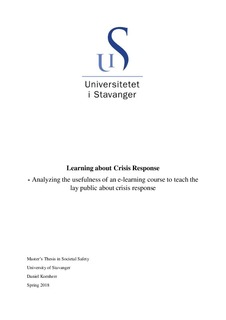| dc.description.abstract | “Emergencies can strike anytime, anywhere and affect anyone. In emergencies, 90% of lives are saved by people like you. You can be a hero by learning and providing first aid when the time comes and ensuring first aid training is accessible to all.” (International Committee of the Red Cross, 2014)
Crisis may hit anywhere, at any time, and anyone could be involved in it. Imagine being in a crisis – a car accident, a fire, a terror attack. What would you do? As the quote of the International Committee of the Red Cross suggests, in most cases, it is an average person that saves lives. It usually takes time before emergency services arrive at the scene of crisis, and it is therefore crucial that the persons at the scene, no matter if directly affected by the crisis or not, help each other and do their best to reduce damage and prevent more harm from occurring. First aid is crucial, but there are many more ways in which someone can help. This research tries to analyze whether the e-learning course 123CrisisTraining is an appropriate resource to teach the lay public how they can respond to, and manage a crisis, and improve their ability and willingness to help.
Originally, it was planned to conduct this research by giving the course to pupils in different municipalities in Norway. Pupils would have gotten a questionnaire both before and some time after conducting the e-learning course, to see whether they learned something from the course, and if that helped improve their willingness and ability to respond to crisis. By comparing the results from both municipalities with each other, it was planned to analyze whether geographic differences would have an effect on the results, as one municipality might have been more invested in teaching their pupils about crisis than another. However, due to an overwhelmingly negative response to my inquiries, with zero schools agreeing to be part of the research, the approach was changed.
In the end, after having problems with finding enough willing students from the University of Stavanger to participate as well, the research was conducted by using the data from 35 questionnaires, 4 interviews, and a literature study to be able to answer the research questions. Facing numerous problems with finding willing respondents, the scope of the research was also extended to include the identification of possible ways the lay public can contribute to crisis management.
Looking at regulations and laws in Norway, it became evident, that the Norwegian government and emergency services expect the population to be actively involved in the prevention of a crisis, and the preparation and management of it should it occur. In many cases, the population is also more than willing to participate in any way the can as to help people and prevent the situation from becoming worse. This can be seen in various descriptions of small or big crises, such as car accidents, forest fires, or terrorist attacks, to name a few. The public can get involved by giving first aid, evacuating an area, starting search and rescue efforts, informing emergency services about the situation, or by doing one of many other things described in the literature. Data from the questionnaires also suggest that many of the respondents have a rough idea of how they would approach crises, or in fact any accident or crisis related situation in which a person may need help.
Certain assumptions about 123CrisisTraining could be made when comparing its set up with the literature that discusses what is required to make an e-learning course good. 123CrisisTraining offers several of the features defining a good e-learning course, namely the ability to move freely around the course and choose which parts one wants to learn more about, and the combination of visual material, text, exercises, and group work that allows for conversations and discussions.
Interviewees often had somewhat different opinions about the contents of the e-learning course. However, three of the four interviewees all expressed the desire to have a more thorough explanation of what one can do during the acute phase of a crisis, while it is less interesting for the lay public to learn about parts of the post-crisis material, as it is aimed at organizations. It is difficult to come to a definite conclusion about whether 123CrisisTraining is an appropriate e-learning course to teach the lay public about crisis management. It can simply not be answered in this research due to the limited empirical evidence, including the fact that three out of four interviewees had extensive crisis management knowledge even before going through 123CrisisTraining. However, this could not be prevented due to the vast problems with finding other volunteers for this research. | nb_NO |
